- See also: Intrepid (disambiguation) for other Intrepid references.
The Intrepid-class starship was a Federation design that entered service in the latter half of the 24th century. At less than half the size of a Template:ShipClass starship, the Intrepid-class was considered "quick and smart." (VOY: "Scientific Method", "Relativity").
General overview
When first commissioned, the Intrepid-class featured many innovations then becoming available, not least being the tricyclic input manifold of the warp core and variable-geometry pylons. The class was also the first to incorporate bio-neural gel packs and was equipped with the Mark 1 Emergency Medical Hologram system.
Capabilities upon introduction were equally impressive. The class boasted the best navigational sensors, and the highest top speed of any Starfleet vessel until the development of the Template:ShipClass. Its multi-mission design was backed up by a main computer processor capable of simultaneously accessing 47 million data channels and sustaining 575 trillion calculations per nanosecond in operational temperatures From 10 Degrees Kelvin to 1790 Degrees Kelvin. (VOY: "Relativity", "Concerning Flight")
Class history
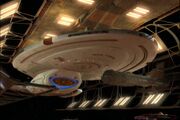
Voyager in drydock at the Utopia Planitia Fleet Yards
Development and construction of the Intrepid-class occurred at the Utopia Planitia Fleet Yards with the class entering service by 2370. The second ship, USS Voyager, was commissioned in 2371. She was the first ship to test the class 9 warp drive in deep space. (VOY: "Caretaker", "Relativity")
The performance of the Intrepid-class was well reflected by Voyager. That ship was notable for independently, and successfully, completing an unscheduled seven-year journey across the previously unexplored Delta Quadrant, 70 thousand light years from Federation space, from 2371 to 2378. The vessel was completely cut off from communication with Starfleet until 2374, and had no access to any Starfleet supplies or facilities for the entire length of its journey. (VOY Season 1 through VOY Season 7)
Technical data
Physical arrangement
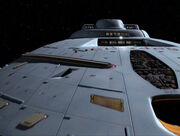
Close-up view of the Intrepid-class' primary hull
The hull configuration of the Intrepid-class adopted the saucer-type shape of previous starship classes, that of primary hull, secondary hull, and nacelles driven by the physics of warp generation and control. One of the Intrepid-class' most notable characteristics were its warp nacelles, which angled when going to warp, a quality which has not been observed in any other starship. The Intrepid-class used a duranium hull structure, a plasma-based power distribution system, and tricyclic life-support systems. (VOY: "Drone")
Following the Starfleet standard, Deck 1 was reserved for the main bridge, with the briefing room and captain's ready room located to port and starboard sides of the bridge. Located in the front section of Deck 2 was the crew's mess hall and the Captain's private dining hall, served by three windows that offered a spectacular view of space in front of the vessel. One deck below, located in the front section of Deck 3, were the quarters of the starship's commanding officer, served by five windows.
The dorsal saucer section was covered by four phaser arrays, two of which extended from the aft curvature along the length of the saucer and. The aft firing arc was covered by two smaller arrays, angled on the rear of the saucer section. The relative bottom of the ship was protected by two similar arrays as on the dorsal saucer section, extending to the rear of the saucer and following the curve towards the bow. (VOY: "Caretaker", "Basics, Part I", "Unimatrix Zero") Docked to the underside of the Intrepid-class' primary hull was the vessel's aeroshuttle.
The landing mechanism
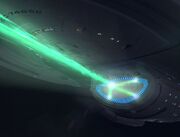
An Intrepid-class deflector emitting a graviton beam
Further aft, the main navigational deflector dish was found at the foreside of the Intrepid-class' secondary hull. Located right above the deflector were the forward photon torpedo launchers. On the underside of the secondary hull were located three sets of plates that support the warp propulsion system. The forward plate covered the reserve intermix chamber; the middle plate contained the antimatter loading port, a large magnetic valve that kept the antimatter from coming in contact with matter during the transfer to the storage pods; (citation needed • edit) and the aft cover plate contained the operational intermix chamber hatch, for ejecting the warp core in case of emergency. (VOY: "Day of Honor")
One of the few Starfleet starship classes capable of atmospheric entry and planetary landing, the Intrepid-class starship was equipped with antigravity generators as well as impulse and lifters strategically placed at the mass and stress points on the bottom portion of the secondary hull. Prior to and during landing or takeoff procedures, the vessel typically went to blue alert, indicating to the crew they were to assume their code-blue stations. (VOY: "The 37's")
Decks
With 15 decks and a mass of 700,000 metric tons, there were 257 rooms on a Intrepid-class vessel. (VOY: "Relativity", "Scientific Method")
- Deck 1
- Deck 2
- Mess hall and Captain's private dining hall (cabin 125 Alpha)
- Deck 3
- Captain's Quarters
- Deck 4
- Transporter rooms 1-3, Cargo Bay 1
- Deck 5
- Deck 6
- Deck 8
- Astrometrics Lab (on Voyager), Cargo Bay 2, docking ports
- Deck 10
- Deck 11
- Deck 14
- Deck 15
- Plasma Relay Room
(VOY: "Parallax", "Phage", "Flashback", "Innocence", "Prey", and more)
Command and control systems
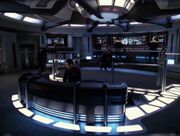
Intrepid-class main bridge
The main bridge of the Intrepid-class starship was ovoid and served as the nerve center of the vessel. At the bridge's rear was a large bank of consoles and data readout screens. Center of that area was the master systems display; control consoles flanked it on both sides. (citation needed • edit)
Starboard of the information center, past the starboard side turbolift, was the station of the chief tactical officer. This area was maintained mostly for internal security and combat situations. Other systems that could be commanded by tactical included long- and short-range sensor arrays, sensor probes, message buoys, and tractor beams. An identical station was found on the other side of the bridge, where the operations console was found. This panel presented the operations officer with a continually updated list of current major shipboard activities. This list permitted Ops to set priorities and allocate resources among current operations. This was especially critical when two or more requests required the use of the same equipment, entailed mutually exclusive mission profiles, or involved some unusual safety or tactical considerations. (citation needed • edit)
Section of the Intrepid-class captain's ready room
Forward of the upper ship operations areas were doorways to the briefing room at one side and the captain's ready room at the other. There, the commanding officer could engage in administrative work with all relevant office equipment at hand without interfering with bridge operations. Also, this room was usually the preferred place where the captain could hold private discussions or receive classified communications. Aboard the Intrepid-class starship, the work desk was the focal point of the ready room, located ahead of the main entrance door. A raised level in the forward section of the room featured a small table, a curved couch, and a replicator. The wall behind the couch featured three windows looking toward the bow of the vessel. Compared with the much larger Template:ShipClass starship, the Intrepid-class curiously had a more spacious, luxurious ready room. (citation needed • edit)
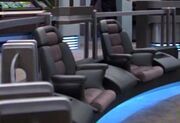
The chairs of the captain and first officer on the Intrepid-class bridge
In the center of the Intrepid-class' bridge was the command area. Here, seating was provided for the vessel's commanding officer and his or her first officer, seated to the captain's left. Between these chairs was a miniaturized status display. Using keyboard or vocal commands, the commanding officer could use these controls to override the basic operation of the starship. Directly aft of this area, integrated in the handrail encircling the aft section of the central command area, was another command console that could be operated to perform more bridge duties. (citation needed • edit)
On Voyager, it was shown to be a console that assisted mostly in operations and tactical stations, due to Seven of Nine's expertise.
Directly forward of and two steps lower than the central command area was the conn station. From here, the flight control officer served as helmsman and navigator for the starship. Despite many of these functions being heavily automated, their critical nature demanded a humanoid officer to oversee these operations at all times. During spaceflight at impulse, conn monitored relativistic effects as well as inertial damping system status. When the ship was traveling at warp speed, conn monitored the subspace field geometry in parallel with the engineering department. During warp flight, the conn console continually updated long-range sensor data and made automatic course corrections to adjust for minor variations in the density of the interstellar medium. (citation needed • edit)
To the conn's right sat the chief engineer. Though the position was far better served in main engineering, situations arose where the engineer's presence was needed on the bridge. The console allowed complete control over all engineering systems. Directly opposite sat the chief science officer at a similar console. (VOY: "Caretaker")
Propulsion systems
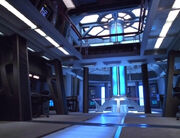
Main engineering
Main engineering aboard an Intrepid-class starship was located on Deck 11. The room was constructed around the matter-antimatter reaction assembly class 9 (also known simply as the warp core class 9), featuring two levels. In front of the warp core was a large monitoring area on the lower engineering level. Also located on this level was the chief engineer's office and an open work area for special projects or situational analysis. A second tier ringed the upper level of main engineering. A small, single-person elevator, as well as a ladder on the opposite side, provided access to this catwalk. (VOY: "Caretaker")

The intermix chamber of an Intrepid-class starship
The main impulse engines on an Intrepid-class starship were located on the aft end of the pylons leading to the warp nacelles. Intrepid-class starships were also equipped with auxiliary impulse reactors. (VOY: "Phage")
Warp core ejection
In the event of a warp core breach, the Intrepid-class starship could eject the warp core. This procedure required the authorization code of the chief engineer or a member of the senior staff. The core was ejected through the ejection port on the underside of the secondary hull. Magnetic rails inside the channel accelerated the core once disengaged from the vessel and fired it away from the ship. Under normal circumstances, the vessel then moved away from the core as fast as possible under impulse power. (VOY: "Renaissance Man")
Should the core not go critical, the vessel could recover it with tractor beams and careful manipulation. (VOY: "Day of Honor")
Tactical systems
Phaser systems
An Intrepid-class starship firing its phasers
The Intrepid-class utilized a ship-mounted phaser array system. The dorsal saucer section was covered by four phaser arrays, two of which extended from the aft curvature, along the length of the saucer and stop short of the auxiliary deflector incision. One phaser array extended behind the bridge. The aft firing arc was covered by two smaller arrays, angled on the rear of the saucer section. The relative bottom of the ship was protected by two similar arrays as on the dorsal saucer section, extending to the rear of the saucer and following the curve to the auxiliary deflector incision. More protection was provided by an array that extended across the ventral engineering hull just fore of the warp core ejection port. Far-aft strips were provided on the underside of the mobile nacelle pylons and under the shuttlebay landing deck on the underside of the ship for a total ship's complement of fourteen phaser arrays, plus 2 separete phaser banks ( the Intrepid-class aft launchers have phaser banks (VOY: "Dragon's Teeth" )) . (Star Trek: Voyager)
Torpedo systems
The Intrepid-class housed five standard torpedo launchers (two fore and two aft, and one on the dorsal side of the ship ). The USS Voyager was loaded with type-6 photon torpedoes in 2371. She also had at least four class-10 photon torpedo warheads and two tricobalt devices in her torpedo arsenal, as well as spatial charges. Quantum torpedoes were also compatible with Intrepid-class launchers, with some modification. (VOY: "Caretaker", "Resolutions", "Dreadnought", "Scorpion, Part II", "In the Flesh", and more)
Deflector shields
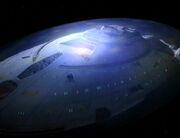
The Intrepid-class' deflector shields react under incoming fire
The Intrepid-class' deflector shield was a symmetrical, oscillating subspace graviton field. During combat, the shield sent data on what type of weapon was being used on it and what frequency and phase the weapon used. Once the tactical officer analyzed these data, the shield could be configured to have the same frequency as the incoming weapon, but different nutation. This tactic dramatically increased shield efficiency. There were a total of fourteen shield grids on the Intrepid-class. (citation needed • edit)
Tractor beam
Each Intrepid-class tractor beam emitter was directly mounted to the primary members of the vessel's framework. The forward emitter was located on the underside of the secondary hull under the main deflector dish. The second emitter was located at the aft end of the secondary hull in the aft section of Deck 14. (citation needed • edit)
Crew support systems
Medical facilities
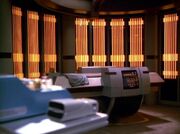
The intensive-care unit
There was one large sickbay facility located on Deck 5, equipped with an intensive-care unit (ICU), biohazard support, critical care, a morgue, the chief medical officer's office, a load-out of three standard biobeds and one surgical bed in the main ward, and a small medical laboratory. The standard medical staff consisted of a doctor and a nurse, supplemented by the Emergency Medical Hologram, the Intrepid-class being one of the first to be equipped with this medical technology. (VOY: "Tuvix")
The main ward
Three biobeds lined the walls of sickbay's ICU; these were for patients receiving medical care and were equipped with biofunction monitors. Located in the corner of the main ward was a surgical bed, where major surgeries were performed and critical patients were treated. A large, sophisticated sensor cluster was installed in the ceiling directly above this bed. Working with a medical tricorder, the sensor suite could give detailed information about a patient's condition. The bed was also designed to use a surgical support frame. The small area that the surgical bed was located in could be isolated by a force field. If necessary, surgery could be conducted in the intensive care ward if there was an overflow of patients or if another patient was present to donate blood. (VOY: "Phage", "Latent Image")
Located in the center of the sickbay facility was the chief medical officer's office. Here, the CMO was provided with an area to work in privacy or conduct meetings with patients, staff, and others. Its proximity allowed the CMO to be present in sickbay almost immediately. Located behind this office was a small medical laboratory facility. The medical staff or other associated personnel could monitor experiments or run tests here during their duty shifts. Just off the medical lab was located a tiny area for storage of the deceased. (VOY: "Macrocosm", "Basics, Part II")
Recreational facilities
There were two holodecks aboard the ship. Located on Deck 6, these holodecks were proprietary Federation technology and could comfortably support fifteen people at a time. The Intrepid-class' holodecks were of a next generation of holographic technology, even further advanced than those applied on board Starfleet vessels during the 2360s, being able to impersonate matter even at the molecular level. (VOY: "Phage")
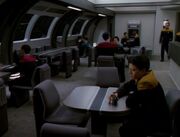
Crew mess hall on board an Intrepid-class vessel
On the Intrepid-class vessels, the mess hall was on Deck 2, Section 13. Some ships were equipped with four food replicators, with a private captain's dining room just behind the mess hall. This dining room could be reconfigured to serve as a kitchen, as done by Neelix aboard Voyager. The USS Bellerophon's mess hall was also fitted in this manner. (VOY: "Phage"; DS9: "Inter Arma Enim Silent Leges")
The mess hall was typically host to many social gatherings, including diplomatic affairs, birthday parties, and holiday celebrations. The mess hall could also serve as a makeshift sickbay whenever that facility was disabled or otherwise overwhelmed. (VOY: "Someone to Watch Over Me", "Latent Image", "Macrocosm", "Homestead", "Before and After", "Year of Hell", "Course: Oblivion", "Memorial")
A crew's lounge was located in the far aft section of the vessel's secondary hull, providing a view of space aft of the Intrepid-class starship. (citation needed • edit)
The Intrepid-class also had a gymnasium. (VOY: "Eye of the Needle")
Crew accommodations
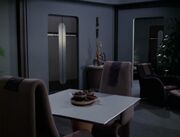
Officers' quarters on board an Intrepid-class starship
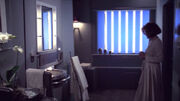
A bathroom
All crew and officers' quarters (except the captain's quarters on Deck 3) were located on decks 2, 4, 8, 9, and 13, with special variable environment quarters on Deck 11 for crew with special comforts. Although the Intrepid-class was highly advanced, the quarters in general were smaller than those of other vessel classes because of its smaller dimensions. (citation needed • edit)
There were several types of crew quarters aboard:
- Standard crew quarters:
- These small quarters units were located within the primary hull and lack windows. They included a living area, a bedroom, and a bathroom. Crewmembers of lieutenant junior grade were given their own quarters; ensigns and crewmen were required to share their quarters (except for senior officers; Ensign Kim had his own quarters). The living area contained a replicator terminal and was customizable with a variety of furniture and decorations. (VOY: "Good Shepherd")
- Officers' quarters
- These quarters lined the edge of the saucer section and contained a living area, a bedroom, and a bathroom area. They were generally reserved for those of ranking lieutenant or higher. Members of the senior staff were typically assigned quarters featuring a pair of larger, wider windows. (citation needed • edit)
- Captain's quarters
- The captain's quarters, located on Deck 3, were similar to the officers' quarters but were slightly larger. The captain had a large desk area and work terminal. His or her quarters featured five windows (below the navigation lamp), which offered an excellent view of space in front of the vessel; the captain's quarters were positioned below the mess hall. (citation needed • edit)
Transporter systems
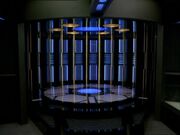
Intrepid-class transporter room
The Intrepid-class featured three transporter facilities that were located on Deck 4. In case of emergencies, injured personnel could be directly transported to sickbay from anywhere in transporter range, including inside the ship. (VOY: "Shattered")
Like many Federation starships, the Intrepid-class' transporters had six standard pads located in front of a control console. Here the transporter controls were located in an elevated booth, and two officers could operate the in conjunction with a wall panel for more complicated transports. Like most systems aboard the Intrepid-class, the transporters utilized bio-neural gel packs in their processor systems. (VOY: "Shattered", "Counterpoint")
Auxiliary spacecraft systems
Interior of shuttlebay
Located in the aft dorsal portion of the secondary hull, the main shuttlebay was the primary port for entrance and egress, as well as management of auxiliary craft and shuttles. The main shuttlebay was managed by a team of pilots, engineers technicians, and operations personnel that were based on the flight operations office under the supervision of the flight control officer. (citation needed • edit)
Inward from the main shuttlebay was a secondary storage and maintenance area behind huge inner airlock doors. This secondary area was almost as large as the main shuttlebay and was commonly referred to as Shuttlebay 2. (VOY: "In the Flesh")
Overview of shuttlebay
The Intrepid-class starship was typically equipped with the following types of shuttlecraft:
- Class 2 shuttle
- Type-6 shuttlecraft
- Type-8 shuttlecraft
The crew of the USS Voyager, stranded in the Delta Quadrant, constructed the Delta Flyer for more complex auxiliary spacecraft operations. The craft was in operation since early 2375. The Intrepid-class was also equipped with an aeroshuttle, which was visible on the underside. (VOY: "Extreme Risk", et al.; ENT: "Future Tense")
Ships commissioned
- USS Bellerophon (NCC-74705)
- USS Intrepid (NCC-74600)
- USS Voyager (NCC-74656)
Appendices
Appearances
- Star Trek: Voyager
- DS9: "Inter Arma Enim Silent Leges"
- ENT: "Future Tense" (database image)
Background
- Some of the information in this article is adapted from Rick Sternbach's guide to the development of the class from Star Trek: The Magazine Vol 3, Issue 1, under the Starfleet Technical Database banner.
- Although the writers of Voyager insisted on trotting out the 9.975 cruising speed figure in dialog once every season or two, this was never borne out in any episode. In "The Swarm", there was some question as to whether or not the ship could hold warp 9.75 for the twelve hours necessary to cross a region of alien controlled space. At no time in the series did we see the ship go faster. Actual observed performance would suggest a cruising speed of warp 9.75 (though that might also be the twelve hour maximum) and an emergency speed of 9.975 for ten minutes, rather like the 9.8 speed as attained by an original Template:ShipClass starship. Another possibility is that at the time Voyager, being cut off from Starfleet, was not completely up to par in terms of warp speed and warp 9.975 would still be possible if the ship had access to the proper maintenance facilities.
Studio models
Design

Concept art for the opening credits of Star Trek: Voyager
The earliest concepts for Star Trek: Voyager came in September 1993, during the last season of The Next Generation and the second season of Deep Space Nine. Star Trek producers had already begun to plan for a new series set on a smaller starship than the Enterprise-D, but instead of waiting for more clarification, Rick Sternbach immediately started making sketches of this unnamed vessel.
Sternbach's early sketches had Voyager as a streamlined, dart-like primary hull, with a flattened, elongated engineering hull, sporting swept-back runabout-like warp pylons. Later on, it was decided that Voyager would be able to land on a planetary surface, requiring deployable landing gear and other arrangements of resting-on-hull components to be sketched out. Variations filled more paper as the proportions of different parts changed, pieces were added and subtracted, and hull contours, both gently curved and angular, were explored in perspective. Even in the rough sketches, a lot of design ideas got worked out, concerning placement of familiar items like impulse engines and phasers. Not surprisingly, this exercise would be repeated in greater detail with each new approved version of the hull. Preliminary hull cross-sections were drawn in blue pencil to check different internal deck heights, total number of decks, and possibly overall ship length.
During April and May of 1994, the first real sense of the new starship emerged. The slightly angular dart front was smoothed off and nestled into the engineering sections, still assuming a separation capability, and sweeping pylons ended in a set of long nacelles. Doors on the nacelles could open, exposing the warp coils for some new kind of energy jump. Impulse thrusters were buried underneath, as in the runabout, and a large triangular wedge sat atop the ship, possibly acting as a scout craft or long-range sensor array. In this design, all of the familiar Starfleet parts were added, in type and location, much the way they eventually were. A few cut-and-paste variations were assembled, along with a sleeker version that left out the long-range sensor pod and combined a few shape ideas from the runabout and the Template:ShipClass. Here, a few more details crept in, notably the large forward sensor cutout, and a stepped engineering hull that supported a ring of large cargo bays and impulse engines. This particular variant received additional approval from the producers and proceeded to the initial blueprint and study model stages. Sternbach scaled up a top plan view sketch of the ship to a length of 48 inches – the presumed size of the motion control model at the time. From the top view, Sternbach derived bottom, side, fore, and aft views. The side elevation (and resulting cross-section) showed 14 decks, and that the ship was about 1,000 feet long (the same size as the upgraded Enterprise from The Motion Picture). This would make it about 303 meters.
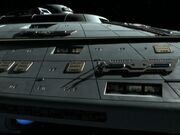
Close-up view of the primary hull, showing escape pod hatches, sensor panels, a phaser strip and crew quarter windows
There seemed to be no insurmountable problems from the design standpoint in giving it all the proper fictional starship systems, or of building and filming the miniature. The set designs could be matched in shape and color. This version of Voyager looked fast, with a hint of solid engine hardware showing on the outside. Just as Sternbach was about to produce a final set of modelmaker's blueprints, the producers asked if he could make Voyager a bit more blended, more curvy; just as a physical model of the USS Voyager had been completed, the producers called for softening the hull contours. Sternbach also still worked on the nacelle placement, mounting them on pylons like on the Enterprise-D, or downturned like on a runabout, and horizontal pylons that evolved into wings.
Following the Starfleet standard, Sternbach reserved spaces for the bridge on Deck 1 and a variety of placeholder windows on the hull, which would be built into standing sets. Windows are an important design factor because of the coordination necessary between various studio departments and an outside modelmaker over continuity of the exterior of the ship and the interior. Since Voyager would be smaller, structures like windows would be proportionately larger and more visible, requiring more model details matching the stage sets. The large windows that appear on the upper side of the Voyager model were designed by Rick Sternbach to accommodate the living quarters of the starship's senior officers, the five windows located underneath the officers' mess on the foreside of the ship being allocated to the captain's quarters. For all quarters, the same set was used on the show with removable wall segments being used to make it either a two-, three-, or four-window quarter (presumably the fifth window of the captain's quarters serviced its bathroom).
Prototype

The Voyager study model
The "Voyager Prototype" was a study model designed by Rick Sternbach during the pre-production of Star Trek: Voyager. This was a mock-up only, it was not built as a filming miniature. Featuring many details that would make it into the producer's final choice for the design of the Intrepid-class USS Voyager, this prototype featured sharper, more angular shapes, and long, downswept warp nacelles mounted on pylons designed similarly to those on the Template:ShipClass runabout. This is very similar to the kitbashed filming model that was labeled USS Elkins, leading to those two models to be sometimes confused. This design came very close of becoming the definitive one for Voyager. As Sternbach remembers, "I was ready to produce a final set of modelmakers's blueprints when a request came down from the producers – they had been perusing the study model for a while – which asked if I could please make Voyager a bit more blended, a bit curvier, like a Lexus. I looked at the latest sketch and pondered a bit. Sure, I thought. Why not." (Star Trek: The Magazine Volume 1, Issue 19, page 25).
The study model is no longer in the possession of either Rick Sternbach or Paramount Pictures but wound up in the possession of a private collector who up to recently was trying to sell it through eBay [2].
Physical model
Starting on 16 June 1994, Rick Sternbach needed about a month to re-design the model along the "curvier" lines requested before it was approved. The model, eventually a collaborative design effort by Sternbach, Richard James and Michael Okuda (who had to match the interior sets with the outer appearance of the ship), was eventually build, after Sternbach produced detailed blueprints in August 1994, as a five feet physical model [3] at Tony Meininger's Brazil-Fabrication & Design. The model was also outfitted with tiny still photographs of interior settings behind windows, a practice started with the Ten Forward section of the Template:ShipClass star ships in TNG.
For the episode "The 37's" part of the landing gear was recreated as a physical model in May 1995, while the whole landing sequence was done in CGI. And for "Parallax", effectsman Joe Bauer had to construct a low budget scale model of the landing bay out of cardboard and miscellaneous kit parts since the CG company that was to compose the approach scene, could not deliver on time and on budget.
Later, a small scale model of the Voyager was also constructed, probably a modified Revell-Monogram kit, for personal use as a study model for Sternbach. It was never used for filming and later sold on eBay.
The physical model, known as Lot#357 estimated at $10,000 – $15,000 was sold on 6 October 2006 with a winning bid of US$110,000 (US$132,000 including buyer's premium). The winner of the lot, a man from Leicester, England, was interviewed in The History Channel's documentary Star Trek: Beyond the Final Frontier.[4] Foam core camera test models of various sizes have been sold in the July 2008 and January 2009 It's A Wrap! sale and auctions for $305,00, $599,00 and $157,65 respectively.[5][6][7]
CGI models
At the time of inception of the Voyager series however, CGI was becoming more affordable and the decision, prompted on by David Stipes was made to have also a CGI model made for the intricate title sequence in which both models were to be used. Santa Barbara Studios, the effects company responsible for creating the sequence, originally used their own low-resolution CG model while mapping out the sequence. Upon completion their model was replaced with a more detailed and finished model built at Amblin Imaging by John Gross and Grant Bouchet. Amblin had the physical studio model scanned and digitized at Cyberscan which built a detailed wireframe CG model. That model was then turned over to Amblin for mapping, detailing and animation using high resolution pictures taken from the physical model. In the end their model consisted of over 300,000 polygons, one of the most complicated models of that time. As a precaution and back-up, Stipes and Ronald B. Moore decided to have Santa Barbara Studios also construct a full fletched CG model. Using different software meant that the two models were not interchangeable. The same methodology was used as with the "Amblin"-model, their scanning and digitizing done at Viewpoint. Nevertheless, it was mostly the "Amblin"-model that was used in the subsequent episodes of the first two seasons of Voyager (The experience garnered by Santa Barbara Studios, would prove useful however when it came to digitizing the Enterprise-E for Star Trek: Insurrection).(Cinefantastique, Vol.27, No.4/5, pages 72-75, 79-81)
This made Voyager the first Star Trek series where CGI was used from its very inception to the end of its run. Viewers could distinguish between the CG and physical models by observing the windows at the utmost aft under the landing bay. The CG model had the windows lighted whereas the physical model had not since there was no room in that area of the model to install electrical wiring. As time progressed, CGI became more and more cost effective and the special effects more ambitious to a point when the physical studio model was rarely used anymore in the latter seasons. After Season 2, Foundation Imaging took over the CGI work for Voyager and part of its work was remapping the "Amblin"-model of Voyager, done by Robert Bonchune.[8]
Designing the bridge
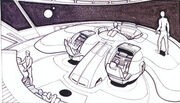
A Jim Martin concept art for the Intrepid-class' bridge
After six years as production designer on The Next Generation, Richard James was no stranger to the legacy of Star Trek and the production requirements of episodic television. When given the assignment to create a new starship from the inside out, he had to start up from scratch. Nothing had yet been established, and thus for his first meeting with Star Trek: Voyager's creators and producers, James decided to push the boundaries of everything that had gone before. Early concept sketches show bridge designs without the large viewscreen in the front of the bridge and command functions decentralized, obviously breaking the traditional bridge mold.
However, by exhaustively reexamining the dramatic requirements and technological underpinnings of the Star Trek bridge without preconceptions, James rediscovered the strengths of the basic template laid out by Matt Jefferies almost thirty years earlier. But with the broad strokes of the bridge's layout firmly embedded in Star Trek's past, James and his team went on to bring a fresh new interpretation to the heart of every Star Trek adventure, investing it with a sleek, efficient, and welcoming appearance that made Voyager something of its own – the Star Trek for the nineties and beyond. (citation needed • edit)
Apocrypha
- The Intrepid-class starship was featured in Activision's Star Trek: Armada II and Star Trek: Starfleet Command III, while the USS Voyager appeared in Star Trek: Voyager - Elite Force and Star Trek: Elite Force II.
- In Bethesda Softworks' Star Trek: Legacy, the Intrepid-class is a playable ship, with the USS Voyager as one of the possible names of this class of ship.
- The "prototype"-design has been referenced by the Last Unicorn Games' role playing game books; they assign the name of the Template:ShipClass to this ship, although this bears no regard for the producers' and creator's intentions. The Voyager's registry number on original plans was NCC-73264, but this was changed before the study model was built.
Sources
- The Art of Star Trek, Judith and Garfield Reeves-Stevens, Pocket Books, 1997.
- "Designing the U.S.S. Voyager", Star Trek: The Magazine, November 2000, issue 19 and July 2001, issue 28.
External links
- Template:NCwiki
- Intrepid-class at Wikipedia
- Intrepid-class Design Linage at Federation Starship Datalink
- Designing the USS Voyager at Federation Starship Datalink
- A Close Look at the USS Voyager NCC-74656 at Federation Starship Datalink
- Interview with designer Rick Sternbach at Forgotten Trek, July/August 2005.
